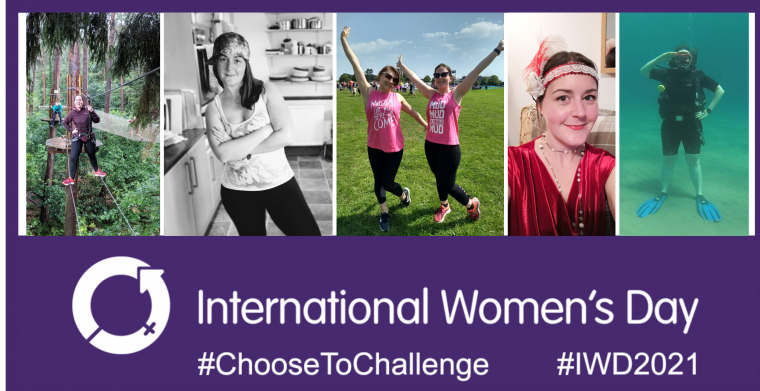Conversation with Our Systems Engineering Consultant, Charlie Kenney on company culture, inclusive work environment and her personal journey to find an organisation where she feels she belongs.
The World again pauses to celebrate International Women’s Day on 8 March. This year’s theme, #ChoosetoChallenge, focuses on to challenge and call out gender bias and inequality. As a female engineer working in a male dominated industry, what inequality, bias or stereotyping have you come across personally that you would like to change for the better?
I have been quite lucky in my career in that I have rarely been exposed to inequality and stereotyping based on my gender. When it has occurred, it has generally been down to an individual’s behaviours rather than a group culture.
Could you give an example?
Looking back, there are a few cases that stand out from the beginning of my career. There were a couple of companies I interviewed with which didn’t explicitly say anything about preferring male staff members but I definitely got the feeling that they would be less comfortable with female staff or anyone who didn’t fit the same mould as their current employees.
One company was a small business which (at that point) consisted of all male engineers. The interviewers talked a lot about golf weekends with the ‘lads’ and I got the impression that being part of the ‘golf crowd’ was important to befriending upper management and building company relationships. I told them I didn’t like golf so wasn’t surprised that I didn’t get the job. They seemed to be looking for people who had similar personalities and interests to their own and it felt like a very exclusive rather than inclusive environment.
This is a classic case of “affinity bias”: it means that we gravitate toward people like ourselves in appearance, beliefs, and background. And we may avoid or even dislike people who are different from us.
When working in a small company I can see that it would be tempting to choose to employ someone who you would enjoy working with rather than someone who may be more skilled for the job and could bring the most value and innovation but with whom you may not be able to build the same rapport. In my opinion, there should be an amount of compromise as there is a danger that you create a very cliquey atmosphere.
Affinity bias can mean that talented people are left out of your workforce or not given the same opportunities for development and career progression. Any diverse voices will be suppressed or ignored and consequently, decisions can be impaired. If you have lots of people with the same perspectives, opinions and personality types you will stifle your creativity, decision making and innovative thinking.
It sounds like you had a lucky escape there. Have you ever walked away from work opportunities because you felt you could not be yourself and succeed?
Another job I interviewed for involved lots of travel and staying for long periods of time in remote areas with a large crew of workers/engineers. I remember almost all of the interview questions were based around how well I dealt with conflict, being away from my family, how I felt about working in mostly male teams, how I deal with challenging behaviours etc. When I asked others at the recruitment day about their interview questions the male applicants seemed to get a different set of questions, focusing more on their technical expertise and work experience.
This is a great example of “attribution bias”: because we see women as weaker or less competent than men, we tend to give them less credit for accomplishments and focus on their potential “shortcomings”.
Aside from the obvious bias in interview questions, I got the feeling the recruiters were really concerned about how female staff would be treated by others on these work sites. This made me worried about their staff culture and behaviours and it actually made me feel that I would be unsafe working there. Needless to say, I didn’t try my hardest during the rest of the recruitment day. This is a job that I would have turned down. Companies have a responsibility to ensure their workplace is a safe and welcoming space for all their employees.
There is still a continuing need across all sectors for more inclusive behaviours to be forged. What advice would you give to these organisations to become more inclusive?
These are both instances of where the company culture needs to change for them to really be inclusive of all people. Instead of focusing on “fixing someone” so that they fit in, they need to change the culture so everyone can be themselves and still succeed. For example, I have often heard people who have more stereotypically “effeminate” traits talk about how it can pay off to display more “masculine” behaviour to gain respect and notice in the workplace. This is not something anyone should have to do to be heard.
Cultural change is difficult to manage as it is dependent upon the staff in that company being willing to accept that there is an issue and change their attitudes and behaviours. I think building a healthy and inclusive work environment relies on a company being unafraid to proactively search out and address areas for improvement. To mitigate these biases, companies need to make sure that employees are aware of them. Many businesses are afraid to admit they are less than perfect but this prevents progress. Creation of a safe space for employees to discuss such issues openly and without fear of judgement or punishment can really help here.
How about your current work and the people you work with?
I have been lucky in the companies that I have chosen to work for. My current employer, Optima Systems Consultancy may not seem the most diverse company on paper however, it has always had a very inclusive environment and I feel like I am judged on my performance, skills and behaviours rather than my gender or any other factors.
My colleagues here are respectful and I feel we have a good culture of learning and improvement. As a company we seem to recognise that we are by no means perfect and everyone seems happy to take feedback should someone point out a concern. The recent companywide training on unconscious bias definitely helped me recognise my own internal biases and behaviours (I have definitely been guilty of showing affinity bias and confirmation bias in the past), although overcoming these is a work in progress.
Thank you for sharing your experience with us! So, what do you #ChoosetoChallenge this year?
I would challenge companies to embrace change when it comes being confronted with a shortcoming rather than going on the defensive. Change is hard, it takes time and effort. The first step is being willing to accept that no company is perfect, and that there is always room for improvement. They need to share this attitude of continuous improvement with employees and give them the power to help identify and address shortcomings. One way to approach this could be to set up networks and open up communication with staff to enable them to openly discuss the issues they face within the workplace, or to discuss their own preconceptions and bias without judgement. Companies need to be willing to have these uncomfortable discussions and to learn from them.
On an individual basis, I would also challenge everyone to consider their own attitudes and biases. We all have these and we should not be afraid to confront them. True equality and inclusivity are not possible without everyone challenging their own conscious or unconscious bias and seeking to overcome these.
—————————————————————————————————————————————————
Recommended free videos and training on unconscious bias:
Challenging Unconscious Bias in the Workplace
IWD 50 Ways to Fight Bias presentation



